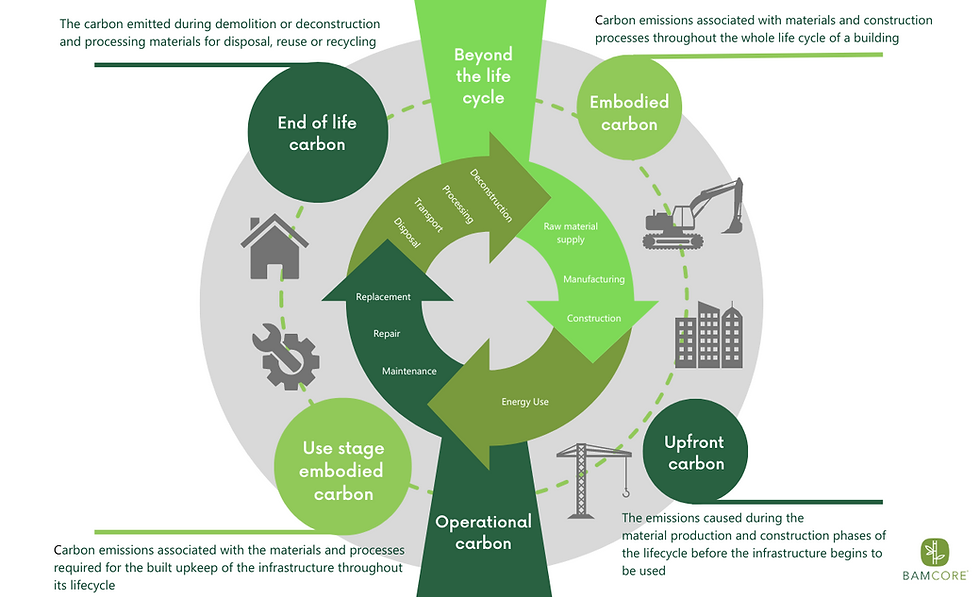Growing Resilience with Biogenic Building Materials
- Tobe Sheldon
- Sep 24, 2024
- 4 min read
Decarbonizing the Built Environment, Enhancing Building Resilience and Socio-Economic Benefits

The construction industry is at a pivotal moment in its evolution, facing urgent calls to reduce its environmental impact while enhancing building resilience. Rapidly renewable biogenic building materials are emerging as a game-changing solution, offering a path to decarbonization, improved building performance, and green jobs in underprivileged locations. These materials, derived from fast-growing plant sources, are transforming the way we think about construction.
The Power of Biogenic Carbon Capture
Biogenic building materials, such as timber bamboo, hemp, straw, and cork, possess a unique ability to sequester carbon dioxide from the atmosphere as they grow. This natural carbon capture process gives these materials a significant advantage over traditional construction materials in terms of carbon footprint. For instance, timber bamboo can sequester 500-600% more carbon dioxide than typical building materials, making it an exceptionally effective tool in the fight against climate change.
Rapid Renewability: A Key Advantage
Rapidly renewable resources, as defined by the U.S. Green Building Council, are materials that can regenerate themselves in 10 years or less. This rapid growth cycle enables sustainable harvesting and ensures a consistent supply of materials without long-term environmental degradation. Bamboo exemplifies this efficiency, growing up to 20 meters in its first year—a feat that would take timber trees 25+ years to achieve.
The land use efficiency of these materials is particularly noteworthy. A study published in Scientific Reports highlights that "bamboo can produce up to 25 times more biomass per hectare than wood.” This remarkable yield means less land is required to produce building materials, potentially alleviating pressure on forests and agricultural lands. The combination of rapid renewability and efficient land use, coupled with reduced embodied carbon, improved energy efficiency, and long-term carbon storage, positions biogenic materials as powerful tools in sustainable construction and land management. These attributes not only contribute to more environmentally friendly building practices but also offer a pathway to more efficient and sustainable land use in the face of growing global resource demands.
Decarbonizing the Built Environment
The use of rapidly renewable biogenic materials in construction offers significant potential for reducing both embodied and operational carbon emissions. According to The Impact, BamCore's framing systems, which utilize timber bamboo and Eucalyptus, can reduce the embodied carbon of a building by 40% compared to traditional framing methods. This innovative approach not only addresses embodied carbon but also improves operational efficiency. According to a third-party case study conducted at BamCore’s request, their framing solutions can decrease the energy needed for heating and cooling by 25-50% in a typical 1,100 square foot unit.
Furthermore, buildings constructed with biogenic materials act as long-term carbon sinks, storing carbon for the life of the structure. As noted by the Carbon Leadership Forum, "a sizable reduction (~60%) in embodied carbon is possible in two to three years by bringing readily available low-carbon materials into wider use.” This combination of reduced embodied carbon, improved energy efficiency, and long-term carbon storage makes biogenic materials a powerful tool in a greener future.
Enhancing Building Resilience
Rapidly renewable biogenic materials significantly enhance building resilience through their unique properties. According to a study published in the Journal of Cleaner Production, "Bamboo-based construction systems have shown superior performance in terms of seismic resistance and thermal insulation compared to conventional building materials."
This demonstrates the potential of biogenic materials to contribute to building resilience. The U.S. Department of Energy notes that, "Advanced framing techniques using engineered wood products can reduce thermal bridging and improve overall building envelope performance."
This suggests that biogenic materials can help buildings maintain comfortable interior temperatures despite external climate fluctuations, a crucial factor in adapting to climate change. These properties position biogenic materials as potential components in creating resilient buildings capable of withstanding and adapting to environmental challenges.
Biogenic Building Materials: Economic and Social Benefits
The adoption of biogenic building materials offers a multifaceted solution to climate change, health concerns, and economic development, particularly in underdeveloped communities. These materials, derived from rapidly renewable sources like hemp, straw, and bamboo, not only sequester carbon but also create opportunities for sustainable agriculture and manufacturing.
According to the International Labour Organization, the transition to a green economy could create 24 million new jobs globally by 2030, with many of these in developing regions. As noted in a report by the Carbon Leadership Forum, "a sizable reduction (~60%) in embodied carbon is possible in two to three years by bringing readily-available low-carbon materials into wider use."
This shift towards biogenic materials can stimulate local economies, providing green jobs in farming, processing, and construction. For instance, the recent inclusion of hempcrete in the U.S. residential building code appendix signals growing acceptance and potential for job creation.
Furthermore, the United Nations Environment Programme states that "green jobs not only contribute to preserving or restoring environmental quality but also offer adequate wages, safe working conditions, job security, reasonable career prospects, and worker rights."
By fostering the growth of biogenic material industries, we can address climate challenges while simultaneously providing sustainable employment opportunities in developed and developing economies.
Challenges and Future Outlook
Despite their numerous benefits, the widespread adoption of rapidly renewable biogenic materials faces challenges, including the need for updated building codes, performance standardization, and scalable manufacturing processes. However, recent policy initiatives and research funding, such as the U.S. Department of Energy's $39 million commitment to biogenic materials research, signal growing recognition of their potential. As we move towards a greener future, rapidly renewable biogenic building materials offer a promising path to decarbonize the built environment while enhancing resilience. By harnessing the power of nature's fastest-growing structural fibers, we can create buildings that minimize their environmental impact and actively contribute to carbon sequestration and climate change mitigation. The construction industry stands at the threshold of a green revolution, with biogenic materials leading the way towards a healthier and happier future for all.

.png)
Comments